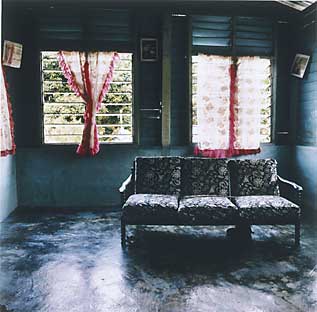
The 258 photographs that form Dalam, (Malay for deep; inside; interior), are the outcome of Simryn Gill�s travel across the Malaysian Peninsula over an 8 week period. Gill knocked on the doors of strangers and asked if she could enter their houses to photograph their living rooms. Perhaps surprisingly, most said yes, and the resulting works are a fascinating index of how people live as well as conveying why the artist undertook this project.
The artist made this work in response to a question she asked herself; "In conceiving the work I had wondered what the 'inside' of a place might look like. Do lots of people held together by geography add up to the idea of a nation or single unified group? The place that I chose to look at is one that is inside me, but also one that I have been removed from for a very long time. In this respect, embedded in this work was a demand that I made on myself to confront the conflicting experience of being both insider and outsider, by requiring myself to persuade people, strangers, locals, to trust me and to let me into their homes."
This major new body of photographs is part of an exhibition that features a selection of Simryn Gill's work from the last decade. Through photographs, objects and installations Gill consider how we experience a sense of place and how both personal and cultural histories inform our present moment. Her work also suggests how culture becomes naturalised, an almost invisible part of our physical environment.
Gill also works with the books, narratives and texts that provide a framework through which we order and describe the world around us. In Pooja/Loot (1992), Gill carved and sliced into old books to create shrines and niches. Found discarded objects were placed in the shrines, creating household gods from inconsequential things. This also creates a leakage of meaning between these everyday items and the words and language which literally forms a contextual halo around them.
In Forest (1996-98), lush tropical foliage is invaded by torn book pages mimicking natural forms to become banana flowers, aerial roots on fig trees, mangroves emerging from mudflats, variegations on leaves and decaying vegetation at the base of epiphytic ferns. Gill's photographs record this strange hybrid nature before the paper rots away, suggestive of how nature is culturally inscribed and the futility of this attempt at containment.
In Washed Up, 1995, water worn glass engraved with words is strewn across the gallery floor. This glass has been collected on beaches on the west coast of Malaysia and the southern islands of Singapore. Each water and sand smoothened piece of glass has an English word etched on it. Gill has said about this work:
"I remembered as a child standing on those beaches wondering what was on the other side� [in making this work] I was interested in the way when language leaves one place and washes up at another, something happens to it and ... the meanings of the words change".
Simryn Gill lived in Malaysia, Singapore, India and Britain before arriving in Australia. She has exhibited extensively in Australia, Asia and internationally, including participating in the Sydney Biennale 2002, Berlin Biennale 2001, in Flight Patterns at Los Angeles Museum of Contemporary Art 2000, Asia Pacific Triennial 1999, Cities on the Move at various venues in Europe and Asia, and Transculture at the 1995 Venice Biennale. She was also included in the curated book project Fresh Cream. In addition to this she has had numerous solo projects including a survey show which toured the UK, exhibitions in Australia, Singapore, Malaysia, at Artpace in Texas and the Kiasma Museum in Helsinki.
Accompanying the exhibition will be an illustrated catalogue with essays by Sharmini Pereira, a London-based curator and writer, Heidi Zuckerman Jacobson, Curator at the UCLA Berkeley Matrix Gallery, and exhibition curator Wayne Tunnicliffe.
|